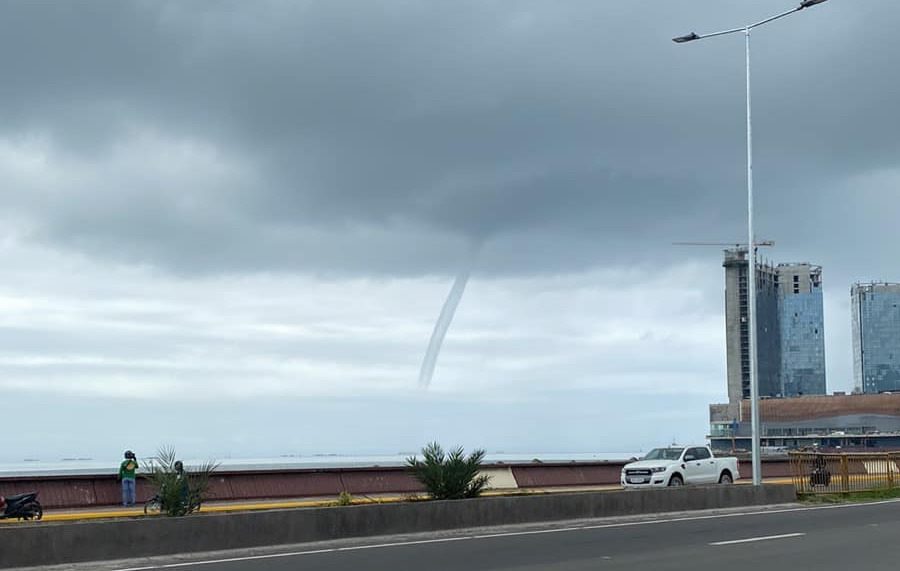What is a waterspout & how do they form?

A netizen snaps a photo of a waterspout forming over the sea waters off the South Road Properties in Cebu City on Tuesday morning, May 3, 2022. | Photo courtesy of Angelo Sam Cordova
CEBU CITY, Philippines – Residents in Cebu City woke up to something unusual on Tuesday morning, May 3.
Just off the coast of the South Road Properties (SRP), a rare weather phenomenon occurred while most people were in a rush to go to work.
A waterspout appeared on the seas within Talisay City, appearing like a narrow tube sticking out of a bag, the spout’s towering presence was seen nearly everywhere in Metro Cebu.
Netizens and even motorists took to social media to share photos and videos of the incredible sight.
State meteorologists from the Mactan bureau of the Philippine Atmospheric Geophysical and Astronomical Services Administration (Pagasa) said they detected the waterspout within the seawaters of Talisay City.
The spout, however, did not last long and did not reach land, prompting local authorities to declare it a ‘passive and non-destructive’ occurrence.
But what really is a waterspout and how do they form?
What is a Waterspout?
A waterspout is often referred to locally as ‘buhawi’. The term buhawi is also used interchangeably to describe other tornado-like weather systems, which is partially true considering that meteorologists consider waterspouts, tornadoes, firestorms, and whirlwinds as closely related.
The name ‘waterspout’, however, can be quite misleading.
Pagasa defined a waterspout as “a tornado-like vortex and cloud occurring over a body of water, frequently in tropical waters”. This means that a waterspout, like the one spotted off SRP, forms above water, and not the other way around.
Furthermore, an entry from National Geographic stated that ‘water inside a waterspout is formed by condensation in the cloud. This means that the water inside a waterspout does not come from the sea or any body of water it came in contact with.
While the recent waterspout found in SRP was short-lived and did not pose any immediate threats, experts noted that the manner of its formation is crucial in determining its potential to destroy properties and even lives.
Types of Waterspouts
Waterspouts need high levels of humidity and warmer water temperature to form. This is why they are commonly found in tropical and subtropical waters.
There are two types of waterspouts: fair-weather waterspouts and tornadic waterspouts. The former usually pose no threat to anything within its vicinity while the latter has the capacity to destroy anything on its path.
The most common type of waterspouts are fair-weather waterspouts and are rarely dangerous, according to the same National Geographic entry.
“The clouds from which they descend are not fast-moving, so fair-weather waterspouts are often static. Fair-weather waterspouts are associated with developing storm systems, but not storms themselves,” it added.
The Cebu City Disaster Risk Reduction and Management Office (CCDRRMO) identified the waterspout off of SRP as a ‘fair-weather type’.
Tornadic waterspouts, on the other hand, are destructive forces. They are called such since they start as ‘true tornadoes’ over a body of water, and have the same characteristics as ‘land tornadoes’.
They can be stationary or move towards land, according to the National Weather Service of the U.S. government.
Regardless of the type of waterspout that formed in a certain area, experts urged the public not to take this weather phenomenon lightly.
“Waterspouts not only put swimmers and boaters at risk, but they also pose a threat to aircraft. Helicopters flying near waterspouts can be damaged and thrown off-course by such intense winds,” the same entry from National Geographic stated. /rcg
RELATED STORIES
Waterspout spotted at SRP not a threat – CDRRMO
Waterspouts form in Daanbantayan
Disclaimer: The comments uploaded on this site do not necessarily represent or reflect the views of management and owner of Cebudailynews. We reserve the right to exclude comments that we deem to be inconsistent with our editorial standards.
